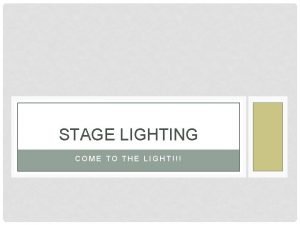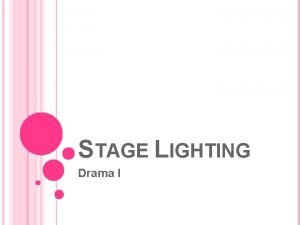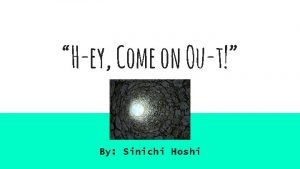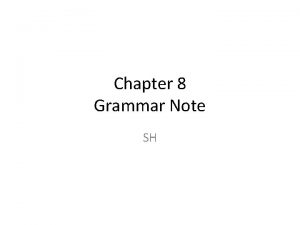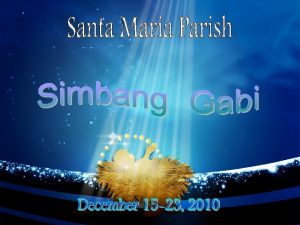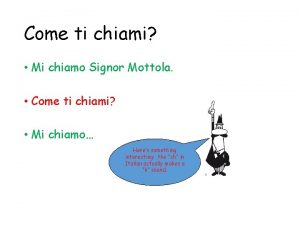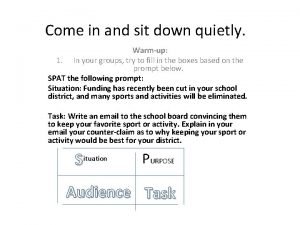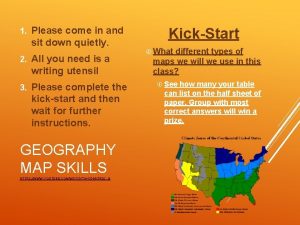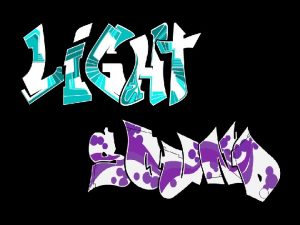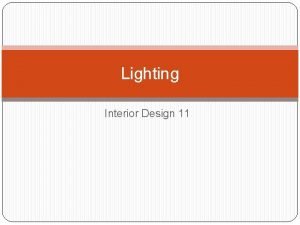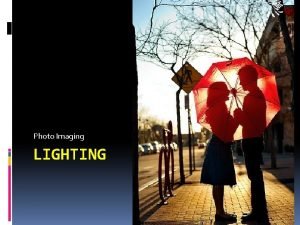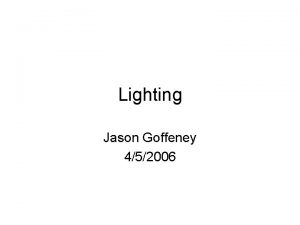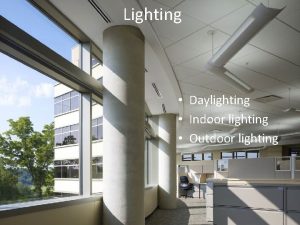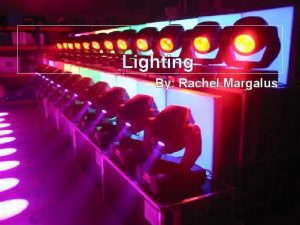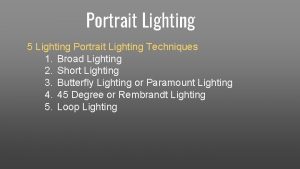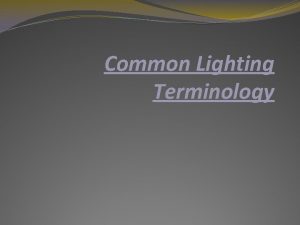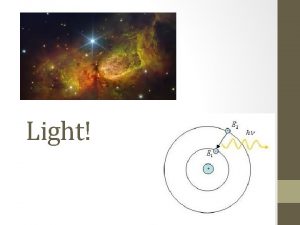STAGE LIGHTING COME TO THE LIGHT FUNCTIONS OF






















- Slides: 22

STAGE LIGHTING COME TO THE LIGHT!!!

FUNCTIONS OF STAGE LIGHTING • Visibility: If the audience can't see the actors, everything else the lighting designer does is a waste of time. Studies have shown that visibility affects our ability to understand spoken speech. This doesn't mean that the audience must see everything all of the time; a German director named Max Reinhardt once said that, "The art of lighting the stage consists of putting light where you want it and taking it away from where you don't want it. "

FUNCTIONS OF STAGE LIGHTING • Mood: (or "atmosphere") "Mood" is the evocation in the audience of the appropriate emotion. Many designers err in paying attention to mood to the point where visibility is sacrificed.

FUNCTIONS OF STAGE LIGHTING • Composition: The act of painting a picture, in this case, with light. • Plausibility: Sometimes called "realism", but that's not always accurate, since not all plays - and certainly very few ballets, modern dance pieces, and operas - are realistic. It's the same quality that Stephen Colbert refers to as "truthiness"

FUNCTIONS OF STAGE LIGHTING • Reinforcement: What are we reinforcing? Everything. • We reinforce the playwright's text: In A Midsummer Night's Dream, Puck has the line, "And yonder shines Aurora's harbinger, " meaning the dawn. The lighting designer can reinforce this by providing the first rays of dawn. • We reinforce the work or the set and costume designers: • We might use colors that flatter or complement those used by our colleagues. • If the sets and/or costumes are sculpted and lush, we might light them so as to highlight their 3 -dimensionality.

FUNCTIONS OF STAGE LIGHTING • Revelation of Form: Decide on the level of 3 dimensionality you want the audience to see. In some productions, you might want a "flat" look; in others – particularly in dance – you might want a more sculpted look. A case could be made that revelation of form is part of composition or mood; however, it's important enough (in some productions, at least) to be a stand alone function. • Punctuation: The blackout at the end of a climactic musical number! The slow fade to black. . •

PRINCIPLES OF COMPOSITION • Unity: The creation of a stylistic plan or concept to which all elements of the production or design conform. Note that while there may be an overall concept for the production, each designer will establish a concept for his or her own design discipline. Ideally, this concept will be rooted in the overall production concept; otherwise, the principle of "unity" is violated.

PRINCIPLES OF COMPOSITION • Harmony: The sense of blending and unity obtained when all elements of a design fit together to create an orderly, congruous whole. Note that for some productions, disharmony is appropriate

WHAT IS THE DIFFERENCE BETWEEN "UNITY" AND "HARMONY"? • Unity is achieved when each element of a design fits in with the overall concept of the production. It is defined by how those elements relate to the production as a whole. • Harmony, on the other hand, is defined by how those same elements relate to each other.

FOR EXAMPLE • In the graphic above, we have achieved both harmony and unity. The icons are all ducks and they are all the same shape and color. It may not be very interesting, but that's due to a lack of variety and contrast, which are concepts that we'll discuss below.

DUCKS • They're still all ducks and still the same shape and size, so we're still achieving unity, but the colors clash — they are not harmonious.

I’M A LITTLE TEA POT the addition of the teapot conflicts with the overall concept of the production — that it's a show about ducks — so we now have neither harmony nor unity:

CONTRAST/VARIATION • Contrast: The juxtaposition of dissimilar design elements. Note that elements can contrast with each other and remain harmonious. The Tony Award winning set and lighting designer David Hays once said that, "The primary tool of any form of design is contrast. " • Variation: Too much uninterrupted harmony is monotonous.

SO WHAT'S THE DIFFERENCE BETWEEN "CONTRAST" AND "VARIATION"? • "Contrast" is a difference in one or more qualities between similar elements. For example: • In the above image, the ducks are similar — they're identical in size and shape — but whereas three of them are red and facing Stage Left, one is blue and facing Stage Right. This is an example of "contrast".

• Compare this to the graphic below, in which all the ducks share the same basic qualities (they're facing the same direction and are the same color), but the fourth one is a radically different element — this duck is flying, while all of the ducks we've seen so far have been swimming. This is an example of "variation".

BALANCE • The arrangement of the design elements to bring a sense of restfulness, stability, or equilibrium to the design. There are two types of balance:

TYPES OF BALANCE • Symmetrical Balance: "mirror image", as in the first example, below. • Asymmetrical Balance: occurs when the composition is balanced in terms of weight and emphasis without one half's being a mirror image of the other half, as in the second example, below.

PROPORTION/EMPHASIS • Proportion: The harmonious relationship (in terms of size) of the parts to each other and to the whole. Physical beauty in humans (or anything else) is largely based on proportion. • Emphasis: Directing the audience's attention to a specific place.

WARM , COOL, & NEUTRAL Warm colors are generally associated with fire and sun light—yellow, red, orange Neutral colors appear warm when compared to a cool color and cool when compared to a warm color- pink, purple Cool colors are associated with the sky and water- blue, green

COLOR AND EMOTION • Every color has some kind of emotion tied to it, and color is just one way that we can express mood with stage lighting. • Red = Anger, Jealousy, Fear • Pink = Love, Light and Airy • Yellow = Poppy, Bright and Happy • Amber = Awakening, Rootsy and Raw • Green = Rootsy, Organic, Calming, Earthy • Aqua = Gentle, Simple, Water • Blue = Water, Night-time, Calm, Sullen • White = Open, Raw, Unfiltered

COLOR MIXING • Sometimes you may not have the gels you need in order to create the effect you want. Below are a few examples of gels to mix. • • Red + Green = Yellow Red + Blue = Magenta Green + Blue = Cyan Red + Green + Blue = White

YOUR ASSIGNMENT • READ AND COMPLETE FRESNEL ARTICLE AND WORKSHEET • Look over notes to prepare for quiz.
 4 functions of stage lighting
4 functions of stage lighting Come rico
Come rico Light light light chapter 23
Light light light chapter 23 Into the light chapter 22
Into the light chapter 22 Chapter 22
Chapter 22 Parts of stage lighting
Parts of stage lighting Ellipsoidal theatre definition
Ellipsoidal theatre definition Come holy spirit come inflame our souls with love lyrics
Come holy spirit come inflame our souls with love lyrics Summary of hey come on out
Summary of hey come on out Come thou fount come thou king lyrics
Come thou fount come thou king lyrics Present participle of drink
Present participle of drink E m m a n u e l
E m m a n u e l Come mi chiamo come mi chiamo
Come mi chiamo come mi chiamo Come lord jesus come and be born in our hearts lyrics
Come lord jesus come and be born in our hearts lyrics Come home come home jesus is calling
Come home come home jesus is calling Vorrei essere al mare
Vorrei essere al mare Come on come on turn your radio on
Come on come on turn your radio on Come mi chiamo come mi chiamo
Come mi chiamo come mi chiamo List simple past verbs
List simple past verbs Come in come in and sit down
Come in come in and sit down Come in come in and sit down
Come in come in and sit down Step one denial step two
Step one denial step two Stage roght
Stage roght
